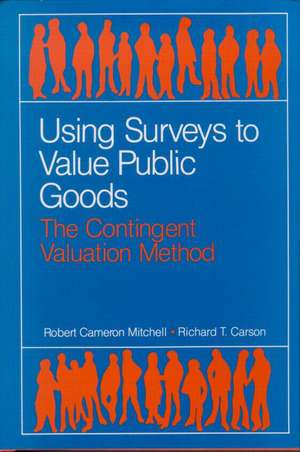Using Surveys to Value Public Goods: The Contingent Valuation Method
Autor Robert Cameron Mitchell, Richard T. Carsonen Limba Engleză Hardback – mar 1989
Preț: 959.24 lei
Preț vechi: 1169.81 lei
-18% Nou
Puncte Express: 1439
Preț estimativ în valută:
183.55€ • 192.15$ • 151.88£
183.55€ • 192.15$ • 151.88£
Carte tipărită la comandă
Livrare economică 05-19 aprilie
Preluare comenzi: 021 569.72.76
Specificații
ISBN-13: 9780915707324
ISBN-10: 0915707322
Pagini: 482
Dimensiuni: 156 x 234 x 33 mm
Greutate: 0.84 kg
Ediția:1
Editura: Taylor & Francis
Colecția RFF Press
Locul publicării:Oxford, United Kingdom
ISBN-10: 0915707322
Pagini: 482
Dimensiuni: 156 x 234 x 33 mm
Greutate: 0.84 kg
Ediția:1
Editura: Taylor & Francis
Colecția RFF Press
Locul publicării:Oxford, United Kingdom
Public țintă
Academic and Professional Practice & DevelopmentCuprins
ForewordPreface1. Valuing Public Goods Using the Contingent Valuation Method2. Theoretical Basis of the Contingent Valuation Method3. Benefits and Their Measurement4. Variations in Contingent Valuation Scenario Designs5. The Methodological Challenge6. Will Respondents Answer Honestly?7. Strategic Behavior and Contingent Valuation Studies8. Can Respondents Answer Meaningfully?9. Hypothetical Values and Contingent Valuation Studies10. Enhancing Reliability11. Measurement Bias
Notă biografică
Robert Cameron Mitchell, Richard T. Carson
Descriere
Economists and others have long believed that by balancing the costs of such public goods as air quality and wilderness areas against their benefits, informed policy choices can be made. But the problem of putting a dollar value on cleaner air or water and other goods not sold in the marketplace has been a major stumbling block. Mitchell and Carson argue that at this time the contingent valuation (CV) method offers the most promising approach for determining public willingness to pay for many public goods--an approach likely to succeed, if used carefully, where other methods may fail. First Published in 1989. Routledge is an imprint of Taylor & Francis, an informa company.












